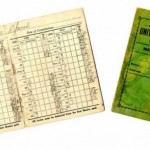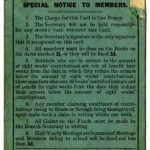In the eighteenth century tailoring was a skilled trade serving the upper classes. By the end of the nineteenth century the sewing machine had been invented, encouraging mass production by ‘clothing operatives’ who were often poorly paid and worked in sweated conditions. A number of trade unions were formed to try and improve the conditions of workers in the textile trade and to represent their interests. These included the Amalgamated Society of Tailors and Tailoresses (1866), Amalgamated Union of Clothiers Operatives (1881), Amalgamated Jewish Tailors, Machinists and Pressers Trade Union (1893) and the London Society of Tailors and Tailoresses (1905). In 1920, the Tailors and Garment Workers Union was formed (an amalgamation between the Scottish Operative Tailors and Tailoresses Association and the United Garment Workers Union). This was followed, in 1932, by the formation of the National Union of Tailors and Garment Workers (an amalgamation of the Tailors and Garment Workers Union and the Amalgamated Society of Tailors and Tailoresses).
-
Amalgamated Society of Tailors & Tailoresses Badge (1900-1932)
Members of Trade Unions would wear badges like this to promote the identity of unions. This society was originally for journeymen tailors but renamed in 1900 when a female section was set up.
-
Trade Union Cards (1920 and 1922)
These cards cost a penny to purchase. They kept a record of payments to the Shop Steward who acted as the eyes and ears of the union.
-
Trade Union Cards (1920 and 1922)
-
Letter from Mr J. A. Flynn, Amalgamated Society of Tailors and Tailoresses to James Middleton (General Secretary of the Labour Party) (1914)
This letter enquires about the possibility of picking up army clothing contracts in World War One, highlighting unemployment amongst members. [Transcript]
-
Mary Macarthur addressing a crowd in Trafalgar Square about the Corruganza box factory strike in Tooting, London (1908)
Secretary of the Women’s Trade Union League (WTUL) in 1903, Mary MacArthur became a spokesperson for women workers, helping them to organise union activity.
-
Lacemakers at Long Eaton Lace Factory
This Derbyshire factory was a successful hub of Nottingham Lace production, owing to the cheaper labour, rents and overheads in its rural location, along with lower levels of trade union activity.
-
National Union of Tailors and Garment Workers (NUTGW) pamphlet (1947)
This pamphlet discusses the Tailors Union from 1885-1909 looking back at the “nationwide agitation” on sweated trades following the Daily Mail exhibition in 1906.
-
Emma Paterson (1848-1886)
Founder of the Women’s Trade Union League (WTUL), which recognised and lobbied for the rights of female workers.
-
Lancashire and Cheshire Women’s Textile and Other Workers Representation Committee (1908)
This committee was formed to ensure that disenfranchised women had a political voice. Their manifesto linked class and suffrage, hoping to relieve poverty and improve working conditions.
-
Barnoldswick Weavers Winders & Textile Workers Association banner
Barnoldswick, Lancashire was the location of 13 cotton weaving mills and provided employment for local people, many living in weavers cottages.
-
National Union of Tailors and Garment Workers (NUTGW) Leeds District banner (After 1932)
This banner depicts various tailors at work, banners portraying women were comparatively rare.
-
National Union of Tailors and Garment Workers (NUTGW) M&C Branch banner (About 1939)
M&C stood for Mantle and Costume, and this banner would have cost about £93 at the time.
-
To Men And Women Garment Workers of England banner (1920s)
This banner was given to delegates of the Trades Union Congress (TUC) by workers from the Tinyakov Sewing Factory in what was then the USSR as a symbol of solidarity. [Translation]
All of the images and texts published in this virtual exhibition are for private use only and not for copying, reproduction or publication. They are low resolution images only. The copyright holder for these digital images is the People’s History Museum, except for the Tailor’s Notebooks and the National Union of Tailors and Garment Workers (NUTGW) pamphlet which have kindly been contributed by the Working Class Movement Library, Salford. Copyright of the original artwork, photographs or products may be held by the artist, maker, photographer or agent. By choosing to view the collections via this website you have accepted these conditions.
We would like to thank Ingrid Francis (MA Museum Studies, Newcastle University) who has worked on the construction of this virtual exhibition as part of her placement at the People’s History Museum. We would also like to thank the National Co-operative Archives, People’s History Museum and the Working Class Movement Library for permitting items from their collection to be used in this exhibition.












